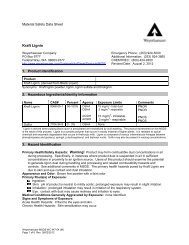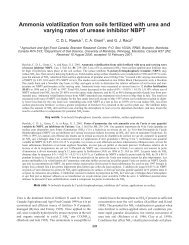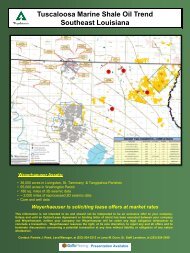Tuscaloosa Marine Shale Oil Trend Southeast ... - Weyerhaeuser
Tuscaloosa Marine Shale Oil Trend Southeast ... - Weyerhaeuser
Tuscaloosa Marine Shale Oil Trend Southeast ... - Weyerhaeuser
Create successful ePaper yourself
Turn your PDF publications into a flip-book with our unique Google optimized e-Paper software.
Executive Summary – <strong>Tuscaloosa</strong> <strong>Marine</strong> <strong>Shale</strong> (Eagle Ford <strong>Shale</strong>), SE Louisiana<br />
Play Concept: <strong>Tuscaloosa</strong> <strong>Marine</strong> <strong>Shale</strong> (TMS)<br />
Drill Depth: TMS: 12,500’ – 16,500’ MD<br />
Reservoir: Over-pressured, organic-rich shale with naturally occurring<br />
fractures.<br />
Pay Thickness: Potential productive interval ranges from 150’ – 300’ thick<br />
Geologic Overview:<br />
The <strong>Tuscaloosa</strong> <strong>Marine</strong> shale (TMS) has long been identified as the source of oil in the Lower<br />
<strong>Tuscaloosa</strong> sandstone and Austin Chalk in Mississippi and Louisiana. Its Texas equivalent, the<br />
Eagle Ford shale, is currently one of the hottest development areas in the lower 48. Wells drilling<br />
through the TMS typically encounter oil and gas shows. Report of oil on the pits is common while<br />
drilling through the TMS.<br />
Devon and Encana are the most active drillers in TMS Play <strong>Trend</strong> in SE Louisiana. Both operators<br />
are utilizing long laterals and multi-stage fracs in their wells. Devon’s initial well (Lane #64-1) is on<br />
strike with <strong>Weyerhaeuser</strong>’s minerals in NW Livingston Pa. Strong TMS oil and gas shows were<br />
encountered in L. <strong>Tuscaloosa</strong> Sandstone test in this area where the TMS is over-pressured (.52 -<br />
.70 psi/ft) and is found at subsea depths of 14,000’ – 16,000’.<br />
Devon is preparing to spud their third TMS test (Soterra #6H-1) just north of <strong>Weyerhaeuser</strong>’s unleased<br />
15,300 acre mineral block in Tangipahoa Parish. In Washington Parish the western half<br />
(approximately 65,000 acres) of <strong>Weyerhaeuser</strong>’s minerals are prospective in the TMS <strong>Trend</strong> based<br />
on oil and gas mudlog shows and the presence of high resistivity (100’ + of > 5 ohm m) shale. In<br />
this area, the separation of the TMS from the Massive L. <strong>Tuscaloosa</strong> Sandstone is substantially<br />
greater than in the fairway of active TMS drilling further to the west which may allow for greater<br />
fracs to be put on the shale.<br />
TMS Rock Properties:<br />
Limited rock data is available on the <strong>Tuscaloosa</strong> <strong>Marine</strong> <strong>Shale</strong>. 5-10% porosity and .01-.50 md<br />
permeability has been reported (Encore, 2008) with significantly higher permeability in fractured<br />
siltstone intervals. Important rock information such as TOC, gas saturation, gas adsorption capacity<br />
and mineralogy is lacking for the TMS in Louisiana. Strong gas shows with corresponding mud<br />
weight cuts of 2 – 3 ppg while drilling through the TMS indicate that the shale likely has permeability<br />
and porosity (i.e., shows are not just gas liberated during drilling). Several wells in Livingston<br />
Parish experienced a continual influx of gas while drilling through the TMS.<br />
Data Summary:<br />
• Core data including detailed fracture analysis (one well in St. Helena Parish)<br />
• Extensive 2D seismic coverage/ reprocessed data<br />
• Well data: mudlogs, drilling reports, etc.









